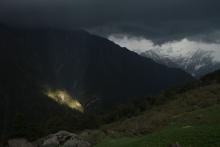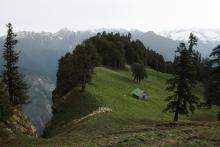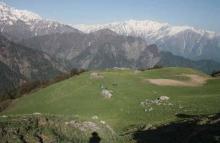Fire and grazing have played a major role in determining the structure and composition of many of the world's ecosystems. The Himalayas experience high levels of livestock grazing and fire. Each of these factors have been studied individually and shown to have influence on ground vegetation composition and structure. However our knowledge on their combined role in shaping these landscapes is limited. The Western Himalayas is part of the Himalayan biodiversity hotspot. Here, people have traditionally been pastoralists depending on the mountainous grasslands for their livelihood. They regularly burn forests in the dry months to encourage a new flush for their livestock. Thus, fire and grazing are two integral parts which together have reshaped these landscapes.
However, the growing concern about over-grazing and increasing fire-frequency as a cause of serious disturbance and a threat to biodiversity has resulted in restriction on grazing and costly protection from fire in several areas over the last few decades. These restrictions, which are based on general perception and neglect the fire-vegetation-grazing dynamics, have affected the pastoralists and may pose a threat to existing biodiversity. Our study aims at a better understanding of the fire-vegetation-grazing relationships which could help in developing better management practices.
The objective of our study is to understand the dynamics of fire-vegetation-grazing in the Western Himalayan landscape which could help in rationalizing the existing management practices. Our study will contribute towards, (a) understanding the role played by fire and grazers, alone and in combination, in structuring the Western Himalayan landscape, (b) determining the effects of over grazing and increased fire frequency on ground vegetation composition, and (c) determining acceptable levels of human activities by way of grazing and /or fire from the point of view of biodiversity conservation.
This project has been completed.
Our results suggested a high occurrence of fire in the landscape, with some of the sites being burnt every year. However, the fire was restricted in its distribution and was observed around villages, mainly in village-grazing grounds called ghasni. We did not find any correlation between different fire frequencies and species composition. Species composition was mainly influenced by elevation and aspect.
Our vegetation results suggest that the richness and diversity of ground vegetation at high altitudes is determined mainly by elevation and area of the pasture. However, at the level of plant functional groups, livestock grazing intensity influences the richness, heterogeneity and abundance of annual species of plants. Richness and relative abundance of annuals was significantly higher in grazed areas compared to non-grazed areas. This richness of annuals also resulted in a greater heterogeneity in these grazed taches. We observed more woody perennials in non-grazed pastures. The presence of annuals is important as they are more palatable to herbivores compared to the perennials.









